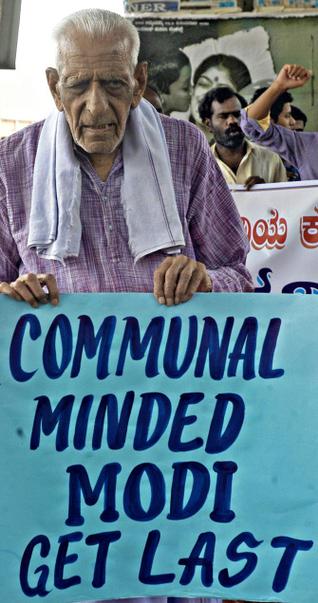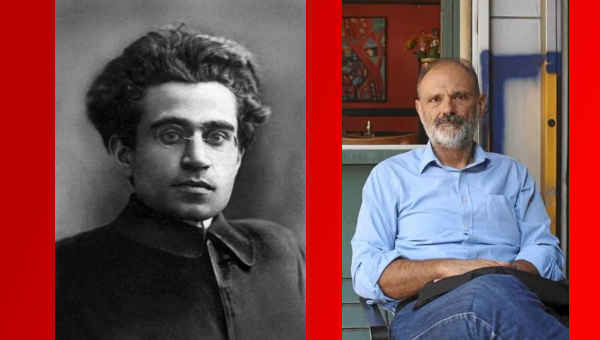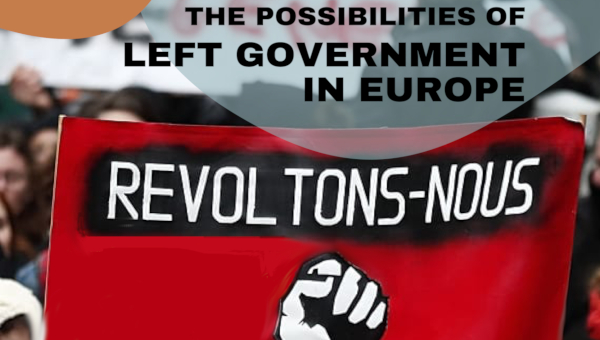In recent times, the Hindu Right appears to be a resurgent political force in India. One of its bastions has been Gujarat, a State in western India. It has been under the political control of the Right under the leadership of Narendra Modi. He is the prime ministerial
candidate of the Bharatiya Janata Party (BJP), the main political wing of the Hindu Right movement. A notorious Hindu communalist, Modi is widely believed to have helped instigate the 2002 Gujarat pogrom in which more than a thousand Muslims were killed and tens of thousands became homeless. Rejected by voters at the last two national elections, the BJP is trading itself as the party of development during the on-going five-week long national election.
Leading the election campaign, Modi has indeed put forward what is known as the Gujarat model of development, which he has been hard selling to obtain votes and to
mask his own and his party’s communal (religious-sectarian) character.

Modi and other proponents of the model say that Gujarat is the number one State, that its economic growth rate has been much faster than other
States, that it has attracted much foreign investment and has industrialized at a very fast pace, and so on. The Right claims that
this model is the best, and should be emulated by all States of India, and indeed by the poorer countries of the world.
It is not difficult to refute the exaggerated view that colors the claim. It has been established that: Gujarat’s economic growth rate
is high, but not as high as it is claimed to be relative to other high-growth States. Gujarat’s record on wages or on child mortality
rates or on literacy is not that good either, relative to many other relatively industrialized and high-income States. Much of what the
Modi government has achieved, it has done so by giving away natural resources and government loans at almost zero cost to certain business groups who have also received huge tax concessions, all of which could have been used to benefit the common people.
Gujarat by the Numbers
Since much statistical evidence has been provided to refute the exaggerated claim about the Gujarat model, I will just cite some evidence from reports that make use of composite index of development, rather than using numbers on single indicators such as income or infant mortality. As per the recent report on India’s Human Development, Gujarat had a score of 0.466 in 1999-2000 and 0.527 in 2007-08, while the best ranking State, Kerala, had a score of 0.677 and 0.790. Gujarat is in the middle. According to a report on economic backwardness produced by a committee led by
Raghuram Rajan (who is now the chief of the central bank), Gujarat’s composite score was 0.49, while the best ranking States, Goa and
Delhi, had scores of 0.05 and 0.09 (lower scores indicating lower level of backwardness). Once again, Gujarat is in middle. In terms of
the composite index of environmental sustainability, in 2010, Gujarat, ranked at 23, has one of lowest scores among all the 28 States; it had a very low score of 20 (on a scale of 0 to 100). In terms of policy effectiveness (which is based on indicators for law and order, livelihood opportunity, and similar other economic variables), Gujarat’s rank is extremely low (at 16), among the States.
The Modi-ite discourse on Gujarat model requires a more thoroughgoing critique than what is often offered by liberals (many of whom support the Congress Party). It is not enough to reject the Gujarat model by saying that Gujarat is doing worse than other states in this or that respect, or that another provincial model may be better than the Gujarat model. The rejection of the Gujarat model has to be a part of the rejection of the whole neoliberal-private enterprise model which has been bought in and accepted by many critics of the Gujarat model themselves.
Critiquing the Right
It is not enough to criticize the development model of the Right by saying that things have not become significantly better under Modi in Gujarat. Even if poverty had come down significantly, even if everyone was able to earn a little more under a regime of the Right and even if there are a few more roads, would one prefer a regime that can potentially crush the most fundamental freedoms – including freedom of religion, speech and assembly and indeed even freedom to show love (think about moral policing on the part of the Right in cities such
as Bangalore)? Can the Right’s promise of better economic performance and governance be detached from its reactionary economic
and social-political ideology? Once again a merely empirical and statistical refutation of the Right’s model is not enough at all.
There is also a real danger to some people (e.g. Professor Zoya Hasan from JNU) carelessly describing Congress’ policies as social democratic, suggesting that it is a progressive alternative to the Right. It is simply not.
The criticism of the Right’s model of development must be from a standpoint which should be also the standpoint of the criticism of the ‘liberal’ or Congress model: in other words, the criticism of both these models must be from one single (common) standpoint. This is the standpoint of the majority of people who have to work for a wage or are petty commodity producers and are barely living a human life. The Gujarat model of development – and indeed the broader neoliberal model itself which the centrists/Congress embrace – negates this standpoint.
Some liberals say that Gujarat model is faulty on the ground that it may have promoted growth but it has not promoted human development.
Saying this is necessary but not adequate. This is because such a criticism mistakenly accepts the following: satisfying the interests of big business which promotes economic growth and satisfying ordinary people’s social-economic needs, which is what human development is about are
both possible within the neoliberal model, a model that is supported by both the Right movement as well as by many of its critics. These critics, once again, include people from Congress; they also include its regional variants and/or opportunistic avatars and the regional implementors of the neoliberal order who may not be either in the BJP or Congress
fold at a given point in time. They more or less believe that the neoliberal model – letting a society and its economy be run by the animal spirits of profit-making – is basically correct except that the government needs to spend a few more rupees per person on education, health, etc., and perhaps preferably in a decentralized manner (i.e. at the State level), so that ordinary working people can be under the juggernauts of the entire conservative economic model in a little more consenting and capable manner. Although on the surface they are critics of Modi-ism, by accepting the neoliberal model itself, they are actually much less critical than they think. Such criticisms and associated political practice can neither achieve development with a human face nor stop fascistic tendencies of the Right.
The development talk that Modi and the Right engage in is a way to sell the wine of naked neoliberalism in the bottle of development and
governance, and thus to gain power at the Center, which can be further used to advance the neoliberal-bourgeois model and the fascistic-communal agenda. In selling its conservative model to the people, the Right movement and Modi Inc. are being properly helped by the national and global business class (including in the diasporic elements) who hope to benefit from a national-level conservative and authoritarian government which will make people gulp bitter pills (read: labour reforms, further privatization of state-owned companies, and the like). These pills will be necessary to cure the
illness of declining economic growth in the bourgeois economy.
Congress’s Critique
Criticisms of the Gujarat model from Congress, the traditional party of big business, and its political and intellectual supporters, are not only
inadequate but also hypocritical. If allowing business people to make money at any cost (with a few crumbs thrown at the poor at one’s whim) is the main model of development, Modi did not introduce that model. He is just shoe-polishing it a bit, putting it to good effect, which is why he has the image of a good or strong administrator, one who makes things happen for sections of the business-class. In fact, the culture of promoting ‘animal spirits’ (m-m-m: making money in the market) is something the Congress’s Prime Minister, a conservative economist, constantly talks about. In terms of this culture, Congress and BJP – center and the right – share a definite common ground. Their quarrel is over who will have access to governmental power. The idea that Congress supports progressive capitalists and the BJP supports crony capitalists reminds one of the old distinction between progressive (national) bourgeoisie and the rest in the ruling class (e.g. feudals; imperialists, etc.). Both the distinctions are as useless as
putrid water. In fact, the failure of the Congress to significantly benefit the masses and reign in corruption in the last 10 years – apart from the absence of any credible alternative which is from the standpoint of the economic-political interests of the masses and which is based on
their independent political-ideological mobilization for (i.e. independent of bourgeois parties) – is partly responsible for the situation in which the Right can now make the claim it does.
“No sections of the ruling class are really committed to values of secularism or democracy in a situation where economic growth is slowing, and economic inequality is growing.”
So, while in terms of economic policy, BJP and Congress are almost the same, in terms of the communalism agenda, the distance between them is less than often imagined: it must be said that Congress does not, and will not, stop adapting to, and compromising on, that agenda. One must continue to ask (while refraining from saying Congress is as communal as BJP): why did Congress not stop the 1992 demolition of the mosque in northern India; why did it not stop the 1984 massacre of the Sikhs in Delhi? Besides, to the extent that a) Congress has ruled longer than any other party (independently or otherwise) and been mainly responsible for economic policy-making, that b) it has failed to resolve the fundamental problems of the masses, and that c) the social crisis and economic anxieties of the masses are partly expressed in the form of conflicts between religious groups (in the sense that the nation’s problems are blamed on the minorities), Congress – the section of the ruling class allied with it – is therefore indirectly responsible for the rise of the Right. The fundamental truth is this: no sections of the ruling class are really committed to values of secularism or democracy in a situation where economic growth is slowing, and economic inequality is growing (India has more than 100 billionaires and world’s third-largest population of Ultra High Net Worth Individuals and, as well, is the home to the largest number of people who are near hungry or hungry), producing a potential danger to public order and the rule of property. It is this fact that is expressed in the resurgence of the Right (and in the relatively weak response of the ‘centrists’ – Congress type people and formations – to that process). There is an objective economic-political reality for the rise of the Right. The latter does not exist merely because of some irrational religious prejudice in the minds of some people.
The broader social-political movement of the Hindu Right and the Gujarat model of development as its specific vehicle and purpose are simply
unacceptable in every way. It must be subjected to complete rejection. And such a rejection must be a part of the rejection of the wider model of development that is being pursued, one that is based on the super-exploitation of wage-workers and dispossession of small-scale property owners. And the Right model should be rejected both now and after the elections (whether or not the Right comes to power), and inside and outside the Parliament. The Hindu Right is the single most threat to the country’s collective conscience, including the right to dissent on the part of ordinary citizens, writers, artists, intellectuals and progressives. It is the most dangerous affront to India’s rich democratic and
secular tradition and to the legitimate aspirations of toiling men, women and children of all religions, castes and provinces, to live a comfortable life.
The only genuine way to fight the Right and the communalization of society and polity and to ensure that ordinary people live a decent
life is to mobilize them on the basis of an agenda that puts democratic collective control of society’s resource and state power
in their own hands. The name of that agenda is a simple one: socialism. And that requires the establishment of a genuinely revolutionary Marxist (economic, political and cultural) movement in India, as part of a wider regional and global process. •
A slightly shorter version of this was published in The Statesman.





